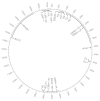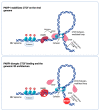Three-Dimensional Chromatin Structure of the EBV Genome: A Crucial Factor in Viral Infection
- PMID: 37243174
- PMCID: PMC10222312
- DOI: 10.3390/v15051088
Three-Dimensional Chromatin Structure of the EBV Genome: A Crucial Factor in Viral Infection
Abstract
Epstein-Barr Virus (EBV) is a human gamma-herpesvirus that is widespread worldwide. To this day, about 200,000 cancer cases per year are attributed to EBV infection. EBV is capable of infecting both B cells and epithelial cells. Upon entry, viral DNA reaches the nucleus and undergoes a process of circularization and chromatinization and establishes a latent lifelong infection in host cells. There are different types of latency all characterized by different expressions of latent viral genes correlated with a different three-dimensional architecture of the viral genome. There are multiple factors involved in the regulation and maintenance of this three-dimensional organization, such as CTCF, PARP1, MYC and Nuclear Lamina, emphasizing its central role in latency maintenance.
Keywords: CTCF; EBV; chromatin looping; chromatin structure; cohesin; epigenetics; latency.
Conflict of interest statement
The authors declare no conflict of interest.
Figures



References
-
- Gewurz B., Longnecker R., Cohen J.I. Epstein-Barr Virus. In: Howley P., Knipe D.M., Cohen J.I., Damania B., editors. Fields Virology. 7th ed. Wolters Kluwer; Philadelphia, PA, USA: 2021. pp. 324–388.
Publication types
MeSH terms
Substances
Grants and funding
LinkOut - more resources
Full Text Sources
Miscellaneous

